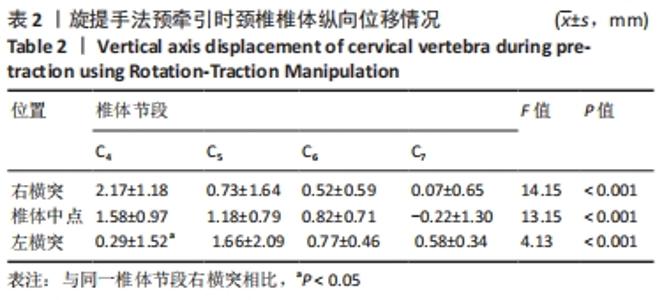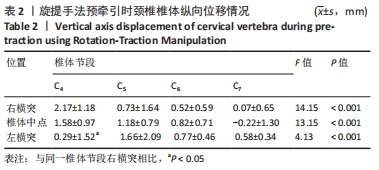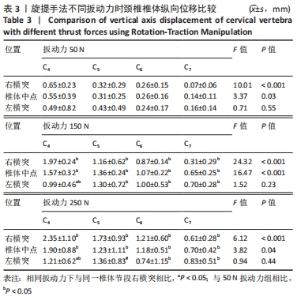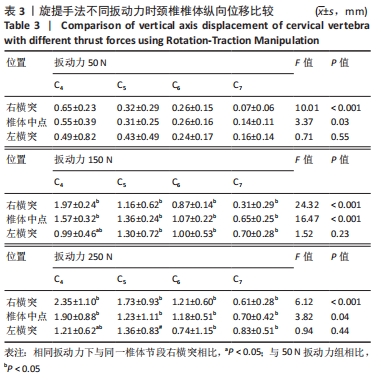[1] 于长岁,朱立国,张晓峰,等.朱立国旋提手法治疗力学失衡神经根型颈椎病经验[J].浙江中医杂志,2019,54(9):635-636.
[2] 朱立国,杨博文,展嘉文,等.旋提手法对椎动脉型颈椎病患者眩晕症状的改善作用及安全性[J].北京中医药,2019,38(7):695-697.
[3] 朱立国,韩涛,于杰,等.中医骨伤科旋提手法规范化操作传承模式初探[J].中医杂志,2018,59(11):927-931.
[4] 王乾,朱立国,高景华,等.旋提手法治疗神经根型颈椎病的疗效观察[J].中医正骨,2009,21(6):9-11.
[5] ZHU LG, FENG MS, YIN XL, et al. Kinematics Analysis of Cervical Rotation-Traction Manipulation Measured by a Motion Capture System. Evid Based Complement Alternat Med. 2017;6:5293916.
[6] 冯敏山,朱立国,魏戌,等.颈椎旋提手法操作轨迹的动态捕捉研究[J].中国康复医学杂志,2011,26(2):176-177.
[7] FENG MS, LIANG L, SUN W, et al. Measurements of cervical range of motion using an optical motion capture system: Repeatability and validity. Exp Ther Med. 2019;18(6):4193-4202.
[8] PROVENCHER B, NORTHON S, GEVERS MONTORO C, et al. Effects of chiropractic spinal manipulation on laser-evoked pain and brain activity. J Physiol Sci. 2021; 71(1): 20.
[9] LIMA CR, SOZIO RS, LAW AC, et al. Effects of Thrust Magnitude and Duration on Immediate Postspinal Manipulation Trunk Muscle Spindle Responses. J Manipulative Physiol Ther. 2021;44(5):363-371.
[10] HAAVIK H, KUMARI N, HOLT K, et al. The contemporary model of vertebral column joint dysfunction and impact of high-velocity, low-amplitude controlled vertebral thrusts on neuromuscular function. Eur J Appl Physiol. 2021;121(10):2675-2720.
[11] LIMA CR, MARTINS DF, REED WR. Physiological Responses Induced by Manual Therapy in Animal Models: A Scoping Review. Front Neurosci. 2020;14:430.
[12] PASQUIER M, DANEAU C, MARCHAND AA, et al. Spinal manipulation frequency and dosage effects on clinical and physiological outcomes: a scoping review. Chiropr Man Therap. 2019;27:23.
[13] GYER G, MICHAEL J, INKLEBARGER J, et al. Effects of biomechanical parameters of spinal manipulation: A critical literature review. J Integr Med. 2022;20(1):4-12.
[14] GIANOLA S, CATTRYSSE E, PROVYN S, et al. Reproducibility of the kinematics in rotational high-velocity, low-amplitude thrust of the upper cervical spine: a cadaveric study. J Manip Physiol Ther. 2015;38(1):51-58.
[15] SAJJADI NB, OTTWELL R, SHEPARD S, et al. Assessing the United States’ most frequently asked questions about osteopathic medicine, osteopathic education, and osteopathic manipulative treatment. J Osteopath Med. 2022;122(5):219-227.
[16] 梅凌,李义凯.定点旋转手法作用下颈椎各节段亚生理区的运动形式[J].医用生物力学,2013,28(3):279-283.
[17] BAGAGIOLO D, ROSA D, BORRELLI F. Efficacy and safety of osteopathic manipulative treatment: an overview of systematic reviews. BMJ Open. 2022; 12(4):e053468.
[18] COULTER ID, HERMAN PM, KOMMAREDDI M, et al. Measuring the Appropriateness of Spinal Manipulation for Chronic Low Back and Chronic Neck Pain in Chiropractic Patients. Spine (Phila Pa 1976). 2021;46(19):1344-1353.
[19] SYMONS B, WUEST S, LEONARD T, et al. Biomechanical characterization of cervical spinal manipulation in living subjects and cadavers. J Electromyogr Kinesiol. 2012;22(5):747-751.
[20] WIDMER J, CORNAZ F, SCHEIBLER G, et al. Biomechanical contribution of spinal structures to stability of the lumbar spine-novel biomechanical insights. Spine J. 2020;20(10):1705-1716.
[21] NOUGAROU F, PAGE I, LORANGER M, et al. Neuromechanical response to spinal manipulation therapy: effects of a constant rate of force application. BMC Complement Altern Med. 2016;16:161.
[22] COLLOCA CJ, KELLER TS, HARRISON DE, et al. Spinal manipulation force and duration affect vertebral movement and neuromuscular responses. Clin Biomech (Bristol, Avon). 2006;21(3):254-262.
[23] COLLOCA CJ, KELLER TS, MOORE RJ, et al. Effects of disc degeneration on neurophysiological responses during dorsoventral mechanical excitation of the ovine lumbar spine. J Electromyogr Kinesiol. 2008;18(5):829-837.
[24] COLLOCA C J, GUNZBURG R, FREEMAN BJ, et al. Biomechancial quantification of pathologic manipulable spinal lesions: an in vivo ovine model of spondylolysis and intervertebral disc degeneration. J Manipulative Physiol Ther. 2012;35(5): 354-366.
|





